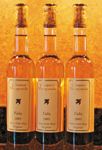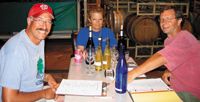Article
Virginia vines and wines
Author(s):
Geoffrey Cooper, MD, FACS, a comprehensive ophthalmologist in solo practice in Richmond, VA, sees his hobby of winemaking as an adventure with three parts: growing grapes, making wine, and marketing the wine.

Of these, his primary interest is growing grapes. Dr. Cooper credits his father with instilling in him a respect for the land and an appreciation of farming.
Growing grapes
"I always had an idea to have a farm, and I knew I needed it to be within an hour of my practice in Richmond," he said. "I began to study soil and topography maps."
He found a 120-acre farm to buy in Louisa, which is between Richmond and Charlottesville.
"I began digging holes and planting vines," Dr. Cooper said. The property had a shell of a metal building, which he turned into the winery. That was 10 years ago and today, his farm includes 12 acres of vines.

His partner in this venture is Jacquelyn Hogge, MD, who practices diagnostic radiology in Richmond.
"As we worked to improve the winery, I realized I was a weak link," Dr. Cooper said. "We brought on board winemaker Graham Bell. You have to let someone better do it and put your ego aside."

Making wine
Cooper Vineyards produces several white wines, including an award-winning Viognier and Coopertage Blanc. They also make red wines, including Merlot, Cabernet Franc, and Norton.
Norton is a native Virginia grape. Cooper Vineyards now features a sweet ice wine called Noche Chocolate, which has the flavor of berries and is infused with chocolate. Their Ice Vidal, Vida, has delicate apricot flavors.
"It's a fun thing, winemaking," said Dr. Cooper. "Trying new things, new blends. We (Dr. Hogge, Bell, and Dr. Cooper) have blind tastings and share our thoughts.
"While larger winemakers work to keep their signature flavor consistent from year to year, smaller wineries, like ours, don't," he continued. "We adjust each season and make the best wine from the grapes each year."
Cooper Vineyards practices gentle fruit handling, bringing in the grapes in "lugs" of 30 pounds instead of tons at a time. This way, not as much crushing occurs, Dr. Cooper said. They do a lot of the labor themselves; pruning, for example, requires specialized knowledge.
Harvest is around Labor Day. It lasted 2 months last season.
Newsletter
Don’t miss out—get Ophthalmology Times updates on the latest clinical advancements and expert interviews, straight to your inbox.




